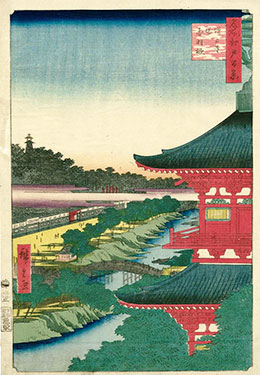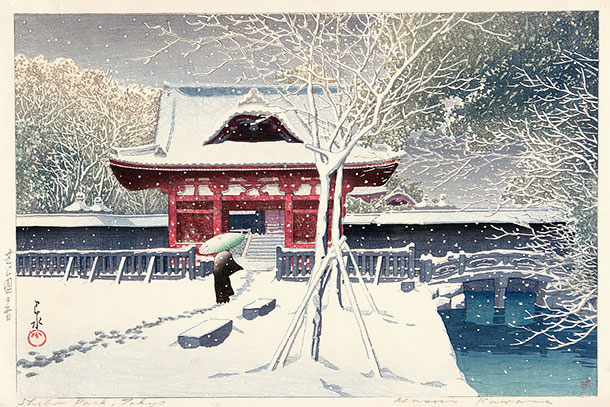

KAWASE Hasui (川瀬巴水)
|
Kawase Hasui (川瀬巴水) was a master of the Japanese landscape print. After beginning a lifelong collaboration with the publisher Watanabe Shôzaburô in 1918, Hasui depicted virtually every mood in all the seasons, from somber moonlit night scenes to daytime views lit warmly by the sun. In many designs Hasui explored the contrast between light and dark. His palette ranged from austere blues and grays to icy winterscapes of limited color to cool autumnal views and brightly colored summer scenes. His vision was an evocative one in its presentation of the Japanese countryside, with its lakes, mountains, fields, rivers, and hotsprings, as well as the cityscape, featuring shrines, temples, bridges, streets, canals, and warehouses.
 |
| Kawase Hasui: Shiba Zôjôji (Zôjô Temple, Shiba: 芝増上寺), 1925 Series: Tokyo nijûkei (Twenty views of Tokyo: 東京二十景) |
One interesting aspect of Hasui's art was his limited use of the human figure: most of his prints have no figures at all, while those that do typically include only one or two. The significance of these figures in Hasui's printmaking has been a matter for speculation. Whether they represented the artist himself, were meant to add some psychological meaning appropriate to the scene, and were simply conventional features of the landscapes and cityscapes may be forever open to interpretation. His figures are often seen from behind or the side and are frequently placed at the edges or in the background of the composition. Their isolation adds a sense of poignancy and stasis that is a trademark of the Hasui style.
 The design above, Shiba Zôjôji ("Zôjô Temple, Shiba": 芝増上寺) from the series Tokyo nijûkei (Twenty views of Tokyo: 東京二十景), was perhaps Hasui's most popular print. First issued in 1925, it was reprinted many times until, it is said, more than 3,000 impressions were taken from the original woodblocks. The impression reproduced here shows in the right margin the seal Watanabe used from approximately 1931-1941 (Hanken shoyû fukyo mosha Watanabe Shôzaburô, meaning "Copyright ownership, reproduction not allowed without permission, Watanabe Shôzaburô"). The left margin reads Shiba Zôjôji ("Zôjô Temple, Shiba") and Taishô jûyo nen saku ("Made in the fourteenth year of Taishô"). It depicts one of the Zôjô temples in Shiba Park, Tokyo during a snowfall. The mausoleums of the Tokugawa family were part of the temples at Zôjôji.
The design above, Shiba Zôjôji ("Zôjô Temple, Shiba": 芝増上寺) from the series Tokyo nijûkei (Twenty views of Tokyo: 東京二十景), was perhaps Hasui's most popular print. First issued in 1925, it was reprinted many times until, it is said, more than 3,000 impressions were taken from the original woodblocks. The impression reproduced here shows in the right margin the seal Watanabe used from approximately 1931-1941 (Hanken shoyû fukyo mosha Watanabe Shôzaburô, meaning "Copyright ownership, reproduction not allowed without permission, Watanabe Shôzaburô"). The left margin reads Shiba Zôjôji ("Zôjô Temple, Shiba") and Taishô jûyo nen saku ("Made in the fourteenth year of Taishô"). It depicts one of the Zôjô temples in Shiba Park, Tokyo during a snowfall. The mausoleums of the Tokugawa family were part of the temples at Zôjôji.
It is interesting to compare Hasui's modern interpretation of this temple with a view of a temple at Shiba for the second shogun Tokugawa Hidetada by Utagawa Hiroshige in his print Zôjôji-tô Akabane ("Zôjôji Pagoda and Akabane"; 増上寺塔赤羽根), 1/1857, no. 53 from his great series Meisho Edo hyakkei (One Hundred Famous Views of Edo: 名所江戸百景); see illustration at right and the bibliography below.* Whereas Hiroshige set his temple against the right side of the composition and included distant views of the Furukawa River and Akabane Bridge, Hasui located his temple centrally and focused upon it to the exclusion of the surrounding landscape. There are more than twenty distant minuscule figures of Edo citizens in Hiroshige's print, while Hasui depicts one of his quintessential solitary figures placed opposite the imposing temple. Pressed against the wind and snow, the diagonal of the figure and her umbrella follow a direction in opposition to the snow-covered branches and the clusters of falling snow. There is both movement and stillness in Hasui's composition, a paradoxical mixture typical of his artistic vision.
 |
| Kawase Hasui: Shiba-koen no yuki (Snow in Shiba Park: 芝公園の雪), 1931 |
 The image shown above depicts another temple in Shiba Park. This ôban-size print was published by Watanabe in January 1931, titled and dated in the left margin Shiba-koen no yuki (Snow in Shiba Park: 芝公園の雪) and Shôwa roku nen ichi gatsu saku ("Made in the first month of the sixth year of Showa": 昭和六年一月作). It has a small red square seal printed in the lower right corner (see image at right), reading Watanabe in hiragana characters (わたなべ), which is uncommon for Hasui prints (it appears more frequently on prints by Itô Shinsui — see Watanabe reference below). It was not one of the standard Watanabe copyright seals and differs from the rectangular Heisei-in (Heisei-period seal, 1989-present) also reading "Watanabe" that is found in the margins of modern late printings (atozuri). The red square seal was apparently used for private publications, gift prints, and proof impressions, although its exact purpose, if there was any beyond identifying the publisher, remains elusive, as does the period of its use.
The image shown above depicts another temple in Shiba Park. This ôban-size print was published by Watanabe in January 1931, titled and dated in the left margin Shiba-koen no yuki (Snow in Shiba Park: 芝公園の雪) and Shôwa roku nen ichi gatsu saku ("Made in the first month of the sixth year of Showa": 昭和六年一月作). It has a small red square seal printed in the lower right corner (see image at right), reading Watanabe in hiragana characters (わたなべ), which is uncommon for Hasui prints (it appears more frequently on prints by Itô Shinsui — see Watanabe reference below). It was not one of the standard Watanabe copyright seals and differs from the rectangular Heisei-in (Heisei-period seal, 1989-present) also reading "Watanabe" that is found in the margins of modern late printings (atozuri). The red square seal was apparently used for private publications, gift prints, and proof impressions, although its exact purpose, if there was any beyond identifying the publisher, remains elusive, as does the period of its use.
The 1936 Toledo exhibition catalog states that 25 printings were required from 20 blocks to produce Hasui's temple scene. In this composition Hasui introduces the surrounding landscape with a river and a small bridge on the right, and especially the snow covered branches that help to animate the scene. Once again a solitary figure is shown, whose right kimono sleeve billows from a gust of wind. © 1999-2020 by John Fiorillo
BIBLIOGRAPHY
- Brown, Kendall H.: Shin-Hanga: New Prints in Modern Japan. Los Angeles County Museum of Art, 1996.
- Catalogue of Collections [Modern Prints]: The National Museum of Modern Art, Tokyo (Tokyo kokuritsu kindai bijutsukan shozô-hin mokuroku, 東京国立近代美術館所蔵品目録). 1993, pp. 93-113, nos. 834-1040.
- Pachter, Shûgô: Kawase Hasui and His Contemporaries: The Shin Hanga (New Print) Movement in Landscape Art. Syracuse, NY: Everson Museum of Art, 1986
- Smith, Henry D., II and Poster, Amy G.: One Hundred Famous Views of Edo. New York: G. Brazillier, Inc. and The Brooklyn Museum, 1986, plate no. 53.
- Stephens, Amy Reigle (Ed.): The New Wave: Twentieth-Century Japanese Prints from the Robert O. Muller Collection. London: Bamboo Pub., & Leiden, Hotei Japanese Prints, 1993.
- Toledo Museum of Art: A Special Exhibition of Modern Japanese Prints. Toledo, Ohio: 1930, illustration no. 81.
- Toledo Museum of Art: Modern Japanese Prints 1936: Woodblock Prints by Ten Artists, The Work of the Past Five Years. Toledo, Ohio:1936, illustration no. 34.
- Watanabe, Shôichirô: "A note regarding Watanabe seals on the prints of Kawase Hasui," in: Kawase Hasui: The Complete Woodblock Prints. (Kendall Brown). Amsterdam: Hotei Publishing, 2003,vol. 2, pp. 45-47 [also see Appendix II, pp. 155-160].
Viewing Japanese Prints |